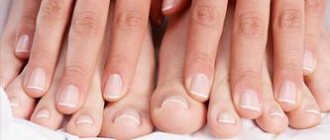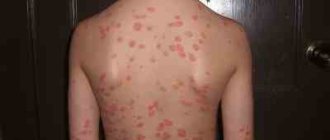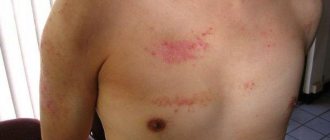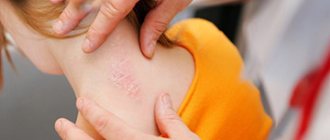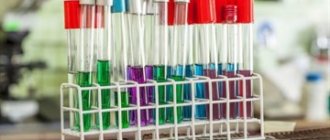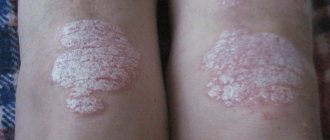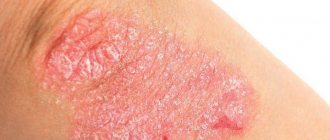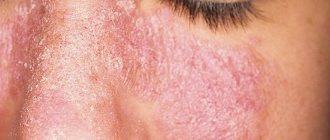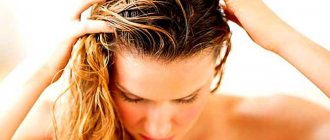What is guttate psoriasis
Guttate psoriasis is a disease characterized by the presence of rashes on the back, shoulders, and thighs in the form of small papules that rise slightly above the surface of healthy skin. They have a bright pink color and can merge over time, forming plaques of small (1–1.5 cm) or large (5–10 cm) sizes. With any localization of pathological elements, the patient experiences discomfort from external changes.
Visible skin lesions dramatically change the quality of life, force you to limit communication with other people and even lead to deep depression.
Psoriasis causes a person to experience severe psychological discomfort
Very quickly the disease goes from an acute form to a chronic course.
Most often, an exacerbation of the process occurs in the spring-autumn period. But sometimes doctors observe “winter” and “summer” variants of the disease.
Treatment with external drugs
Guttate psoriasis is most often treated with topical treatments. These include creams and shampoos with different spectrums of action.
Hormonal ointments
Thanks to the glucocorticosteroids contained in the product, the drug quickly relieves the symptoms of psoriasis. Typically, such ointments are prescribed during an exacerbation. Based on their potency, the products are divided into classes:
- First grade. Contains a minimal dose of steroids. Most often, rashes on the face and neck are treated with such drugs. This is Hydrocortisone, Prednisolone.
- Second class. They have a high concentration of hormones. Can eliminate severe inflammation. This category includes Ftorokort, Lorinden.
- Third class. Should be used for a short course due to the high likelihood of side effects. The active substances of the ointments are absorbed into the bloodstream. This is Advantan, Akriderm.
Despite all the effectiveness of ointments, they cannot be used for a long time.
If the dosage is violated and the course of therapy is extended without permission, side effects in the form of skin atrophy and hormonal imbalance will not be long in coming.
Nuance! Do not use hormonal ointments without first consulting a doctor.
Non-hormonal ointments
These ointments are not as effective as hormonal ones, but at the same time they are the safest. Usually the composition includes plant extracts and zinc. The effect of the drug will be noticeable only after a couple of weeks of use. The following ointments can be distinguished:
- Salicylic;
- Zinc;
- Kartalin;
- Akrustal;
- Daivonex;
- Tsinocap.
These drugs are not addictive and can be used for a long time. Side effects are usually reduced to allergies, but you can easily find an analogue of the previously prescribed drug and continue therapy.
Shampoos
If guttate psoriasis appears on the scalp, it is advisable to treat the disease with specialized shampoos:
- tar;
- antifungal;
- medicinal.
These products not only help get rid of skin disease, but also take care of damaged skin.
Interesting! For the scalp, lotions are also used, which are produced in sprays with a convenient dispenser or sprayer.
Causes
Psoriasis, including guttate psoriasis, often develops after an infectious disease, for example, inflammation of the middle ear (otitis) or streptococcal tonsillitis. The trigger in this case is, apparently, a certain infectious agent that has not yet been fully studied by medicine.
But there are other reasons for the development of the disease:
- exposure to excessively high or low temperatures on the skin;
- long-term stressful conditions;
- heredity;
- metabolic disorders;
- immunosuppression due to viral or bacterial infections.
If there is at least one of these factors, then the possibility of developing guttate psoriasis cannot be excluded. But doctors still cannot give a definite answer why some people develop this disease.
Individual elements (papules) can merge over time into plaques, forming conglomerates of skin lesions
Symptoms and signs
The pathology occurs in waves: periods of relapse are replaced by remission.
Exacerbations occur more often in winter and autumn. Guttate psoriasis is characterized by the following symptoms:
- the appearance of papules (spots) of a pink-red or orange hue, which have the shape of drops;
- peeling of the affected skin;
- inflammation of the epidermis;
- the appearance of small wounds;
- skin itching, burning;
- fusion of papules and formation of plaques.
Rashes form on different parts of the body: elbows, palms, stomach, arms, chest, back, knees, soles. The spots rarely appear on the scalp. Most of them are on the limbs.
Clinical manifestations of the disease
In its development, guttate psoriasis goes through several stages, each of which is characterized by its own symptoms:
- The progression stage is characterized by the appearance of small papules on the skin. Their number is rapidly increasing, individual elements merge with each other, forming large lesions.
The plaques have a bright red base, the surface is white, scaly in structure. The person experiences severe itching in the areas of the rash. Symptoms of guttate psoriasis in the progress stage appear acutely, the rate of rashes is rapid - During the stabilization stage, new elements of the rash do not appear, and the itching subsides. A pigmented ring is formed around the existing papules, and the elements themselves are slightly smoothed out with the skin.
- The resolution stage is characterized by a decrease in the number of skin manifestations .
They leave behind depigmented or hyperpigmented spots. Sometimes guttate psoriasis turns into exudative or patchy. After reducing the number of rashes, depigmented spots remain on the skin
Guttate psoriasis from an infectious point of view does not pose a danger to others.
The disease is not contagious and is not transmitted from person to person or from animals to humans.
There are cases of spontaneous recovery, but most often guttate psoriasis becomes chronic.
Psoriatic rashes are distinguished by three features (phenomena):
- The symptom of a stearin stain is the presence of whitish scales when scraped off.
- The phenomenon of psoriatic film - when the scales are completely removed, a thin film remains on the skin.
- Symptom of “blood dew” - if the integrity of the psoriatic film is disrupted, small pinpoint hemorrhages occur.
When removing the psoriatic film, pinpoint hemorrhages appear on the skin
Features of guttate psoriasis in children
Small spots appear on the surface of the child’s body, which can easily be confused with allergic manifestations such as urticaria. However, over time they rise above the surface of the skin.
In infants, guttate psoriasis can be confused with diaper rash.
You should be especially careful, as single rashes then turn into plaques.
Children, like adults, are susceptible to psoriasis
Sick babies are capricious, their body temperature may rise, and digestive disorders occur (frequent regurgitation, diarrhea). The areas of the rash are itchy and cause discomfort. Parents of such children should consult a specialist as soon as possible. Early treatment helps prevent complications.
What are the stages of the appearance of a rash?
- Progression stage . New pustules appear, severe itching and peeling are noted. When the skin is injured, several more ulcers appear.
- Stabilization stage . The itching is reduced or goes away completely. New rashes stop appearing. The border of skin around the pustule has reduced pigmentation.
- Resolution stage . The rashes disappear, sometimes leaving pigmented areas. It is also possible for this form of psoriasis to transform into another.
Diagnostics
To make a diagnosis of guttate psoriasis, clinical manifestations are sufficient. But to identify complications, a complete examination of the patient is carried out:
- blood test - determine signs of nonspecific inflammation (ESR level, rheumatoid factor, number of leukocytes, eosinophils);
- Analysis of urine;
- culture on nutrient media to identify the infectious agent;
- X-ray examinations and MRI (magnetic resonance imaging) - carried out in case of damage to internal organs;
- biopsy of the affected skin to confirm the diagnosis;
- assessment of the patient's immune system.
Laboratory techniques allow us to exclude an infectious cause of skin disease
Provided that all diagnostic procedures are performed, the correct diagnosis can be made.
Guttate psoriasis in its clinical manifestations is similar to another skin lesion - piteriasis (pityriasis rosea).
To carry out differential diagnosis, you should know that pityriasis rosea is infectious and allergic in nature and manifests itself as spotted pinkish rashes. As a rule, the disease develops against the background of colds, severe hypothermia, and decreased immunity. A single pink spot with smooth rounded outlines appears on the skin, later the center of the spot turns yellow. After a day, the number of similar rashes increases.
Symptomatically, pityriasis rosea is similar to psoriasis, so a number of studies are required to clarify the diagnosis
Pityriasis rosea is also accompanied by severe itching, symptoms of general intoxication of the body (fever, headache, weakness), and has a tendency to quickly become chronic and cause complications.
Methods for getting rid of guttate psoriasis
Official medicine offers the complex effects of medications, phototherapy, plasmapheresis, and physiotherapy for the treatment of psoriasis. It is important to motivate the patient to change their lifestyle: balance the diet, give up bad habits, and avoid stressful situations.
Complex therapy includes the following methods:
- drug effects;
- vitamin therapy;
- balanced diet;
- physiotherapy;
- use of folk remedies.
Treatment of acute psoriasis is best done in a medical facility . It is imperative to identify the infectious agent (if present) and eliminate it as the cause of the disease.
Particular importance is attached to sanatorium-resort treatment of the disease. For patients, resorts with sources of radon and sulfides are indicated. Healing mud with microelements promotes stable remission. Such places of treatment and recreation are located in Altai, the southern coast of Crimea, the coast of the Azov Sea, in Pyatigorsk, Matsesta.
Mineral radon water has an anti-inflammatory, regenerating, immunostimulating effect on the skin, accelerates metabolic processes in it
Drug treatment
The main purpose of drug therapy is to relieve symptoms and generally strengthen the body. It includes:
- antihistamines - to relieve itching and reduce redness on the skin;
- creams, ointments and mash with a drying effect based on salicylic acid;
- hormonal drugs (glucocorticosteroids) - to relieve inflammation (Triderm, Advantan, Diprosalik);
- retinoids - to prevent the proliferation of pathological cells (Neotigazon);
- ointments based on vitamin D3 - for faster regeneration of the skin (Psorkutan, Calcitriol, Daivonex);
- sedatives - to relieve the nervous system (tinctures of valerian, peony, motherwort);
- cytostatic drugs - for severe forms of the disease.
Photo gallery: effective medications for the treatment of psoriasis
Zinc ointment and paste have antiseptic and astringent properties, accelerate skin regeneration
Valerian tincture is a mild sedative that helps relieve nervous tension in the patient and thereby contributes to regression of the acute period of the disease.
Preparations of the retinoid group, including Neotigazon, help restore the healthy appearance of the skin
Hormonal drugs from the group of glucocorticosteroids quickly relieve itching and redness of the skin
Cytostatic drugs (Methotrexate) are used for severe forms of psoriasis; they slow down the rate of cell division of psoriatic plaques
Hardware methods
One of the components of therapy are hardware treatment methods:
- hemosorption is a method of purifying blood from toxins using a special column with activated carbon;
- plasmapheresis is a method of purifying blood plasma, allowing it to be divided into fractions, while “contaminated” plasma is removed, and “clean” elements are returned back into the bloodstream.
After the purification procedure using plasmapheresis, the blood returns to the body
Phototherapy
Phototherapy has a good effect. The method is based on exposure of the skin to ultraviolet light. The frequency of procedures and biodose are prescribed by the doctor.
Currently, there is a relatively new method of treatment - pulsed phototherapy (selective pulsed exposure to ultraviolet rays of different wavelengths on the affected areas of the skin). This method is more effective, as it allows you to adjust the intensity of the effect in accordance with the area and depth of the skin lesion.
The method of selective pulsed phototherapy allows you to act only on damaged cells, since healthy ones absorb less light
An alternative treatment method is PUVA therapy. In this case, the sensitivity of the skin to ultraviolet radiation with a wavelength of 320–360 nm is increased with the help of special preparations (for example, Puvalene), and then the entire body is irradiated with long-wave rays.
Nutritional Features
A rational and balanced diet is of particular importance for the patient. The diet should be aimed at maintaining the acid-base balance in the body. In this case, it is good if the proportion of alkaline medium relative to acidic is 2:1. Based on this, products for the daily diet are chosen.
Healthy foods
Useful and necessary in the daily diet:
- fresh vegetables and fruits, salads from them, seasoned with vegetable oils;
- protein of plant and animal origin (seeds, legumes, lean meats, etc.);
- natural sweets (dried fruits);
- porridge;
- clean water and freshly squeezed juices.
Photo gallery: what to eat for psoriasis
Fruits and berries create the alkaline environment in the body necessary for psoriasis
Cereals are a source of fiber and microelements beneficial for the skin.
Vegetable oils are a source of polyunsaturated fatty acids and vitamin E, necessary for the restoration of the skin.
Water is one of the main elements of recovery. You should consume at least 2 liters per day
Fish dishes enrich the body with healthy fatty acids
Prohibited Products
The following should be avoided in the diet:
- citrus fruits;
- chocolate and confectionery sweets;
- whole milk;
- honey;
- nuts;
- red vegetables and fruits (peppers, strawberries, tomatoes, etc.);
- spicy, sour foods;
- smoked meats;
- alcohol.
Photo gallery: what not to eat if you have psoriasis
Fatty meats provoke inflammatory skin diseases
Nuts increase the risk of allergic reactions
Consumption of spices leads to skin irritation and aggravation of psoriasis symptoms
“Fast” carbohydrates contained in confectionery sweets worsen the condition of the skin
Errors when choosing products are, as a rule, inevitable. Therefore, using the “trial and error” method, an individual diet is selected for a particular patient.
Unconventional methods
During the period of remission, you can begin recovery at home. For this purpose, traditional medicine is used.
Before trying any folk remedy, consult your doctor, because in your case it may be unsafe.
The following methods are especially popular:
- Take 1 teaspoon of sea buckthorn oil orally in the morning and lubricate the lesions on the skin daily.
- Brew stinging nettle leaves at the rate of 1 tablespoon per glass of boiling water, leave, strain and take half a glass twice a day.
- Brew black elderberry flowers at the rate of 3 teaspoons per 0.5 liter of boiling water, let it brew and cool. Before use, strain, take a third of a glass 3 times a day after meals.
- Use fresh celandine juice (with caution) to lubricate psoriasis lesions no more than once a day.
- Use purified fish oil to lubricate the affected areas.
- Use local applications with oatmeal and corn starch. Mix flour and starch, brew with a small amount of boiling water. Place the resulting pulp on a clean, folded gauze in several layers and place it on the psoriatic lesion.
- Use herbal teas from chamomile, string, mint. Mix all the raw materials in equal proportions (1 tablespoon each) and brew 0.5 liters of boiling water, let it brew and cool. Strain and drink as tea.
Photo gallery: folk remedies to combat psoriasis
Sea buckthorn oil is known for its wound healing properties.
Fish oil, when applied to the skin, helps normalize metabolic processes and rapid regeneration of damaged areas
Chamomile and mint tea has a mild sedative and anti-inflammatory effect
Orange juice of celandine has healing and anti-inflammatory properties
Complete cure is possible only in isolated cases; most often, patients achieve stable remission.
Disease prognosis
The prognosis of the disease may differ for each individual patient. For a favorable course, mobilization of the patient’s internal resources and individually selected therapy will be required. The skin can be completely freed from rashes. But we should not forget that the disease is practically incurable. Throughout a person’s life, they will alternate between periods of exacerbation and remission. As the disease progresses, chronic plaque psoriasis can become a complication.
Factors provoking the development of the disease
Today, experts point to multiple causes that provoke the manifestation of the teardrop form of psoriasis. Of these, both endogenous and exogenous factors can be distinguished.
Exogenous root causes of the disease
Why is guttate psoriasis a real surprise for many?
The causes of the disease, as it turns out, may include:
- people living in environmentally unfavorable areas;
- exposure to chemical and toxic substances on the human body;
- unhealthy lifestyle (poor diet, lack of exercise, taking medications for other purposes (antibiotics, vitamins, corticosteroids);
- psycho-emotional overload;
- household and professional trauma to the skin (sun and chemical burns, cuts, insect bites, frostbite, radiation).
Prevention measures
It has long been known that any disease is easier to prevent than to cure. Psoriasis is no exception. If you follow simple recommendations, you can maintain remission for a long time.
To do this you should:
- regulate diet, work and rest;
- perform high-quality sanitization of all possible foci of infection (for example, cure caries);
- carry out hardening procedures;
- engage in physical education and sports in accordance with age;
- avoid psycho-emotional stress;
- If diseases occur, consult a doctor promptly for correct treatment.

